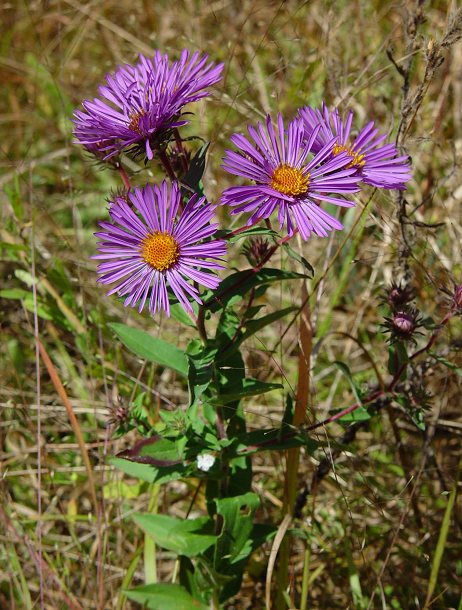Symphyotrichum novae-angliae (L.) G.L. Nesom
New England Aster

Native
CC = 4
CW = -3
MOC = 51
© DETenaglia
Symphyotrichum novae-angliae (L.) G.L. NesomNew England Aster | |
 |
Native CC = 4 CW = -3 MOC = 51 |
© DETenaglia |
|
Family - Asteraceae/Astereae Habit - Perennial forbs with a compact, woody rootstock, usually with 1 or few short, stout, rhizomatous branches, less commonly with longer-creeping, slender rhizomes. Stems - Ascending to erect, to 1.7 m, single or multiple from base, often branched above the midpoint, densely and evenly pubescent with spreading hairs (less so toward the base), also with moderate to dense, stalked glands toward the tip.
Leaves - Alternate, simple, sessile, clasping, auriculate. Basal and lower stem leaves absent at flowering. Median and upper stem leaves often relatively numerous, progressively smaller toward the stem tip, sessile, strongly clasping the stem, the blades 1-12 cm long, narrowly oblanceolate (but often slightly broadened at the base) to narrowly oblong-lanceolate, rarely broader, cordate to nearly truncate at the base, angled or tapered to a sharply pointed tip, the margins entire, hairy, the surfaces moderately to densely hairy, usually with 3 main veins, the secondary veins relatively easily observed abaxially and forming an irregular network of relatively short to somewhat elongate areoles.
Inflorescences - Dense panicles terminating inflorescence branches, the heads appearing mostly long-stalked, the bracts relatively few, 0.5-1.2 cm long, mostly linear. Peduncles densely glandular-pubescent.
Heads - Radiate, showy, 2.0-4.5 cm in diameter at flowering. Involucre 6-12 mm long, the bracts in 3-6 subequal, overlapping series. Involucral bracts mostly linear, long-tapered to the slender, sharply pointed tip, the tip spreading or reflexed, the green portion extending more than 2/3 of the way to the base, those of the median and inner series with a progressively shorter, elliptic, green apical area (this mostly 1/2 the length or more), usually purplish-tinged, the outer surface with relatively dense, stalked glands and often also with sparse, longer, nonglandular hairs (the inner surface sparsely to moderately hairy), the margins with relatively long, spreading hairs. Receptacle flat, naked.
Flowers - Ray florets 40-100 in usually 2 or 3 series, pistillate, the corollas well developed, 10-25 mm long, purple or less commonly pink. Disc florets 50-110, the corollas 4.5-6.5 mm long, the slender portion of the tube shorter than the slightly expanded apical portion, the 5 lobes 0.4-0.7 mm long, 20-25 percent of the total length of the expanded portion. Pappus bristles 4.0-6.5 mm long, mostly pale orangish brown to light tan, occasionally purplish-tinged.
Fruits - Achenes 2-3 mm long, with 7-10 longitudinal ribs, purplish brown to brown, densely hairy and sometimes also sparsely glandular. Flowering - Typically September - October, occasionally as early as July. Habitat - Bottomland prairies, moist depressions of upland prairies, fens, bases of bluffs, streambanks, pond margins, pastures, fencerows, ditches, railroads, roadsides. Also widely cultivated. Origin - Native to the U.S. Lookalikes - Broadly, other species of Symphyotrichum; however, S. novae-angliae is relatively distinctive in appearance. Other info. - This attractive plant can be found throughout most of Missouri but is uncommon or absent in southeastern and southwestern portions of the state. It also occurs across much of the continental U.S., most abundantly in the upper Midwest and New England. Frequent cultivation may partially obscure the natural range. It is one of the easiest asters to identify, having densely leafy stems, big flower heads with numerous purple rays, and a densely glandular involucre. In comparison, S. patens but has cauline leaves which are much more widely spaced on the stem and far fewer rays in the flower heads. S. patens also grows in drier soils of more upland regions. Photographs taken off Hwy H, Shannon County, MO., 9-28-03 (DETenaglia); also near Labadie, Franklin County, MO, 9-28-2008 and 9-24-2020, and at Shaw Nature Reserve, Franklin County, MO, 9-25-2009 and 9-28-2018 (SRTurner). |